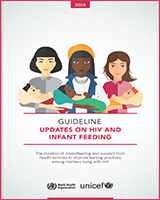Overview
WHO guidelines on HIV and Infant Feeding in 2010 for the first time recommended the use of antiretroviral drugs to prevent postnatal transmission of HIV through breastfeeding. This resulted in a major change from an individualised counselling approach toward a public health approach regarding how maternal and child health services should routinely promote and support infant feeding practices among mothers living with HIV.
Since then, almost all countries prioritised in the UNAIDS ‘Global Plan towards the elimination of new HIV infections among children by 2015 and keeping their mothers alive’ have adopted the approach of promoting and supporting breastfeeding and the provision of lifelong antiretroviral treatment as the strategy to optimise HIV-free survival among HIV-exposed, uninfected infants and children.
Since 2010, a number of questions have arisen following implementation of the recommendations at country level. These questions were identified during a guideline scoping meeting convened at UNICEF in New York, November 2014. The following questions were prioritised and are addressed in the updated guideline.
For how long should a mother living with HIV breastfeed if she is receiving ART and there is no evidence of clinical, immune or viral failure?
Can facility- and community-based interventions improve the quality of infant feeding practices among mothers living with HIV?
If a mother living with HIV does not exclusively breastfeed, is mixed feeding with ART better than no breastfeeding at all
If a mother living with HIV plans to return to work or school, is a shorter duration of planned breastfeeding with ART better than no breastfeeding at all?
The 2016 guidelines provide two Recommendations and two Guiding Practice Statements addressing these four questions. In addition, the guidelines comment on the implications for:
routine monitoring and evaluation and also
conflict and emergency settings.
Suggested citation:
World Health Organization, United Nations Children's Fund. Guideline: updates on HIV and infant feeding: the duration of breastfeeding, and support from health services to improve feeding practices among mothers living with HIV. Geneva: World Health Organization; 2016.
The designations employed and the presentation of the material in this publication do not imply the expression of any opinion whatsoever on the part of the World Health Organization concerning the legal status of any country, territory, city or area or of its authorities, or concerning the delimitation of its frontiers or boundaries. Dotted and dashed lines on maps represent approximate border lines for which there may not yet be full agreement.
The mention of specific companies or of certain manufacturers' products does not imply that they are endorsed or recommended by the World Health Organization in preference to others of a similar nature that are not mentioned. Errors and omissions excepted, the names of proprietary products are distinguished by initial capital letters.
All reasonable precautions have been taken by the World Health Organization to verify the information contained in this publication. However, the published material is being distributed without warranty of any kind, either expressed or implied. The responsibility for the interpretation and use of the material lies with the reader. In no event shall the World Health Organization be liable for damages arising from its use.

